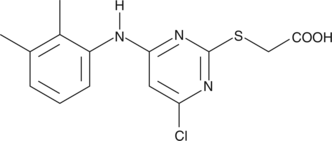Chemicals
Showing 40051–40200 of 41137 results
-
Porcupine (PORCN) is a membrane bound O-acyltransferase that mediates palmitoylation of Wnt family proteins.{27064} This step is required for secretion and biologic activity of Wnt proteins, which have roles in embryonic development and cancer.{27064,27062} Wnt-C59 is a potent inhibitor of PORCN, as measured by prevention of Wnt3A activation (IC50 = 74 pM).{27062} As palmitoylation of Wnt is required for its secretion, Wnt-C59 completely blocks Wnt3A secretion into culture media.{27062} Wnt-C59 prevents activation of all evaluated Wnt family members.{27062} This compound is effective in vivo as well as in vitro. Whether given by intravenous (2.5 mg/kg) or oral administration (5 mg/kg), Wnt-C59 displays a half-life in blood of approximately 1.94 hours, and remains greater than 10-fold above the in vitro IC50 concentration for at least 16 hours after a single oral dose.{27062} It blocks the progression of both basal-like and triple-negative breast cancers while downregulating Wnt/β-catenin pathway target genes in mice.{27062,27063}
Brand:CaymanSKU:-Out of stock
Porcupine (PORCN) is a membrane bound O-acyltransferase that mediates palmitoylation of Wnt family proteins.{27064} This step is required for secretion and biologic activity of Wnt proteins, which have roles in embryonic development and cancer.{27064,27062} Wnt-C59 is a potent inhibitor of PORCN, as measured by prevention of Wnt3A activation (IC50 = 74 pM).{27062} As palmitoylation of Wnt is required for its secretion, Wnt-C59 completely blocks Wnt3A secretion into culture media.{27062} Wnt-C59 prevents activation of all evaluated Wnt family members.{27062} This compound is effective in vivo as well as in vitro. Whether given by intravenous (2.5 mg/kg) or oral administration (5 mg/kg), Wnt-C59 displays a half-life in blood of approximately 1.94 hours, and remains greater than 10-fold above the in vitro IC50 concentration for at least 16 hours after a single oral dose.{27062} It blocks the progression of both basal-like and triple-negative breast cancers while downregulating Wnt/β-catenin pathway target genes in mice.{27062,27063}
Brand:CaymanSKU:-Out of stock
Porcupine (PORCN) is a membrane bound O-acyltransferase that mediates palmitoylation of Wnt family proteins.{27064} This step is required for secretion and biologic activity of Wnt proteins, which have roles in embryonic development and cancer.{27064,27062} Wnt-C59 is a potent inhibitor of PORCN, as measured by prevention of Wnt3A activation (IC50 = 74 pM).{27062} As palmitoylation of Wnt is required for its secretion, Wnt-C59 completely blocks Wnt3A secretion into culture media.{27062} Wnt-C59 prevents activation of all evaluated Wnt family members.{27062} This compound is effective in vivo as well as in vitro. Whether given by intravenous (2.5 mg/kg) or oral administration (5 mg/kg), Wnt-C59 displays a half-life in blood of approximately 1.94 hours, and remains greater than 10-fold above the in vitro IC50 concentration for at least 16 hours after a single oral dose.{27062} It blocks the progression of both basal-like and triple-negative breast cancers while downregulating Wnt/β-catenin pathway target genes in mice.{27062,27063}
Brand:CaymanSKU:-Out of stock
WOBE437 is a potent endocannabinoid uptake inhibitor with IC50 values of 10 and 283 nM for arachidonoyl ethanolamide (AEA; Item No. 90050) and 2-arachidonoyl glycerol (2-AG; Item No. 62160) uptake, respectively, in U937 cells.{40064} It is greater than 1,000-fold selective for endocannabinoid transporters over fatty acid amide hydrolase (FAAH; Item No. 10010183) and the 2-AG hydrolyzing enzymes MAGL, ABHD6, and ABHD12. WOBE437 inhibits AEA uptake in FAAH-deficient HMC-1 human mast cells and Neuro2a mouse neuroblastoma cells (IC50s = 137 and 55 nM, respectively) and reduces AEA uptake by 50% in rat cortical neurons when used at a concentration of 1 μM. It also reduces 2-AG uptake by 40% in Neuro2a cells at a concentration of 5 μM. In vivo, WOBE437 increases AEA and 2-AG levels by 1.5-fold in mouse brain but not peripheral tissues after intraperitoneal administration of a 10 mg/kg dose for seven days. WOBE437 (10 mg/kg) also induces a typical tetrad of hypothermia, catalepsy, analgesia, and hypomotility in mice, indicating it also acts as an indirect cannabinoid (CB) receptor 1 agonist.
Brand:CaymanSKU:23506 - 1 mgAvailable on backorder
WOBE437 is a potent endocannabinoid uptake inhibitor with IC50 values of 10 and 283 nM for arachidonoyl ethanolamide (AEA; Item No. 90050) and 2-arachidonoyl glycerol (2-AG; Item No. 62160) uptake, respectively, in U937 cells.{40064} It is greater than 1,000-fold selective for endocannabinoid transporters over fatty acid amide hydrolase (FAAH; Item No. 10010183) and the 2-AG hydrolyzing enzymes MAGL, ABHD6, and ABHD12. WOBE437 inhibits AEA uptake in FAAH-deficient HMC-1 human mast cells and Neuro2a mouse neuroblastoma cells (IC50s = 137 and 55 nM, respectively) and reduces AEA uptake by 50% in rat cortical neurons when used at a concentration of 1 μM. It also reduces 2-AG uptake by 40% in Neuro2a cells at a concentration of 5 μM. In vivo, WOBE437 increases AEA and 2-AG levels by 1.5-fold in mouse brain but not peripheral tissues after intraperitoneal administration of a 10 mg/kg dose for seven days. WOBE437 (10 mg/kg) also induces a typical tetrad of hypothermia, catalepsy, analgesia, and hypomotility in mice, indicating it also acts as an indirect cannabinoid (CB) receptor 1 agonist.
Brand:CaymanSKU:23506 - 10 mgAvailable on backorder
WOBE437 is a potent endocannabinoid uptake inhibitor with IC50 values of 10 and 283 nM for arachidonoyl ethanolamide (AEA; Item No. 90050) and 2-arachidonoyl glycerol (2-AG; Item No. 62160) uptake, respectively, in U937 cells.{40064} It is greater than 1,000-fold selective for endocannabinoid transporters over fatty acid amide hydrolase (FAAH; Item No. 10010183) and the 2-AG hydrolyzing enzymes MAGL, ABHD6, and ABHD12. WOBE437 inhibits AEA uptake in FAAH-deficient HMC-1 human mast cells and Neuro2a mouse neuroblastoma cells (IC50s = 137 and 55 nM, respectively) and reduces AEA uptake by 50% in rat cortical neurons when used at a concentration of 1 μM. It also reduces 2-AG uptake by 40% in Neuro2a cells at a concentration of 5 μM. In vivo, WOBE437 increases AEA and 2-AG levels by 1.5-fold in mouse brain but not peripheral tissues after intraperitoneal administration of a 10 mg/kg dose for seven days. WOBE437 (10 mg/kg) also induces a typical tetrad of hypothermia, catalepsy, analgesia, and hypomotility in mice, indicating it also acts as an indirect cannabinoid (CB) receptor 1 agonist.
Brand:CaymanSKU:23506 - 5 mgAvailable on backorder
Wogonin is an O-methylated flavonoid isolated from the root of the traditional Chinese herb S. baicalensis with anti-inflammatory, antioxidant, and neuroprotective activities.{22361} At concentrations of 5-50 μM, wogonin inhibits inflammatory activation of cultured brain microglia by diminishing LPS-induced TNF-α, IL-1β, and nitric oxide production.{22362} Wogonin at 75 μM demonstrates tumor therapeutic potential inducing sub-G1 phase apoptosis through activation of caspase-3 activity in human osteocarcinoma cell lines.{22360}
Brand:CaymanSKU:-Wogonin is an O-methylated flavonoid isolated from the root of the traditional Chinese herb S. baicalensis with anti-inflammatory, antioxidant, and neuroprotective activities.{22361} At concentrations of 5-50 μM, wogonin inhibits inflammatory activation of cultured brain microglia by diminishing LPS-induced TNF-α, IL-1β, and nitric oxide production.{22362} Wogonin at 75 μM demonstrates tumor therapeutic potential inducing sub-G1 phase apoptosis through activation of caspase-3 activity in human osteocarcinoma cell lines.{22360}
Brand:CaymanSKU:-Wogonin is an O-methylated flavonoid isolated from the root of the traditional Chinese herb S. baicalensis with anti-inflammatory, antioxidant, and neuroprotective activities.{22361} At concentrations of 5-50 μM, wogonin inhibits inflammatory activation of cultured brain microglia by diminishing LPS-induced TNF-α, IL-1β, and nitric oxide production.{22362} Wogonin at 75 μM demonstrates tumor therapeutic potential inducing sub-G1 phase apoptosis through activation of caspase-3 activity in human osteocarcinoma cell lines.{22360}
Brand:CaymanSKU:-Wogonoside is an active metabolite of wogonin (Item No. 14248) and a flavonoid that has been found in S. baicalensis and has anti-inflammatory and anticancer activities.{49413,49419,49420} It decreases the levels of IL-1β, TNF-α, and IL-6 and inhibits the activation of NF-κB and the NOD-, LRR-, and pyrin domain-containing protein 3 (NLRP3) inflammasome in THP-1 cells differentiated with phorbol 12-myristate 13-acetate (PMA; Item No. 10008014).{49413} Wogonoside (25 and 50 mg/kg) decreases colonic pathological damage and the activity of myeloperoxidase and inducible nitric oxide synthase (iNOS), as well as inhibits NF-κB and NLRP3 inflammasome activation in the colon in a mouse model of colitis induced by dextran sulfate sodium (Item No. 23250). It inhibits phosphorylation of the mammalian target of rapamycin (mTOR), as well as inhibits the growth of (IC50 = 133.9 µM), and induces autophagy in, MDA-MB-231 breast cancer cells.{49419} Wogonoside (50-100 µM) inhibits tube formation by human umbilical vein endothelial cells (HUVECs) and increases Wnt3a levels and β-catenin phosphorylation in MCF-7 cells and reduces tumor growth and angiogenesis in an MCF-7 mouse xenograft model when administered at a dose of 80 mg/kg.{49420}
Brand:CaymanSKU:29332 - 10 mgAvailable on backorder
Wogonoside is an active metabolite of wogonin (Item No. 14248) and a flavonoid that has been found in S. baicalensis and has anti-inflammatory and anticancer activities.{49413,49419,49420} It decreases the levels of IL-1β, TNF-α, and IL-6 and inhibits the activation of NF-κB and the NOD-, LRR-, and pyrin domain-containing protein 3 (NLRP3) inflammasome in THP-1 cells differentiated with phorbol 12-myristate 13-acetate (PMA; Item No. 10008014).{49413} Wogonoside (25 and 50 mg/kg) decreases colonic pathological damage and the activity of myeloperoxidase and inducible nitric oxide synthase (iNOS), as well as inhibits NF-κB and NLRP3 inflammasome activation in the colon in a mouse model of colitis induced by dextran sulfate sodium (Item No. 23250). It inhibits phosphorylation of the mammalian target of rapamycin (mTOR), as well as inhibits the growth of (IC50 = 133.9 µM), and induces autophagy in, MDA-MB-231 breast cancer cells.{49419} Wogonoside (50-100 µM) inhibits tube formation by human umbilical vein endothelial cells (HUVECs) and increases Wnt3a levels and β-catenin phosphorylation in MCF-7 cells and reduces tumor growth and angiogenesis in an MCF-7 mouse xenograft model when administered at a dose of 80 mg/kg.{49420}
Brand:CaymanSKU:29332 - 100 mgAvailable on backorder
Wogonoside is an active metabolite of wogonin (Item No. 14248) and a flavonoid that has been found in S. baicalensis and has anti-inflammatory and anticancer activities.{49413,49419,49420} It decreases the levels of IL-1β, TNF-α, and IL-6 and inhibits the activation of NF-κB and the NOD-, LRR-, and pyrin domain-containing protein 3 (NLRP3) inflammasome in THP-1 cells differentiated with phorbol 12-myristate 13-acetate (PMA; Item No. 10008014).{49413} Wogonoside (25 and 50 mg/kg) decreases colonic pathological damage and the activity of myeloperoxidase and inducible nitric oxide synthase (iNOS), as well as inhibits NF-κB and NLRP3 inflammasome activation in the colon in a mouse model of colitis induced by dextran sulfate sodium (Item No. 23250). It inhibits phosphorylation of the mammalian target of rapamycin (mTOR), as well as inhibits the growth of (IC50 = 133.9 µM), and induces autophagy in, MDA-MB-231 breast cancer cells.{49419} Wogonoside (50-100 µM) inhibits tube formation by human umbilical vein endothelial cells (HUVECs) and increases Wnt3a levels and β-catenin phosphorylation in MCF-7 cells and reduces tumor growth and angiogenesis in an MCF-7 mouse xenograft model when administered at a dose of 80 mg/kg.{49420}
Brand:CaymanSKU:29332 - 25 mgAvailable on backorder
Wogonoside is an active metabolite of wogonin (Item No. 14248) and a flavonoid that has been found in S. baicalensis and has anti-inflammatory and anticancer activities.{49413,49419,49420} It decreases the levels of IL-1β, TNF-α, and IL-6 and inhibits the activation of NF-κB and the NOD-, LRR-, and pyrin domain-containing protein 3 (NLRP3) inflammasome in THP-1 cells differentiated with phorbol 12-myristate 13-acetate (PMA; Item No. 10008014).{49413} Wogonoside (25 and 50 mg/kg) decreases colonic pathological damage and the activity of myeloperoxidase and inducible nitric oxide synthase (iNOS), as well as inhibits NF-κB and NLRP3 inflammasome activation in the colon in a mouse model of colitis induced by dextran sulfate sodium (Item No. 23250). It inhibits phosphorylation of the mammalian target of rapamycin (mTOR), as well as inhibits the growth of (IC50 = 133.9 µM), and induces autophagy in, MDA-MB-231 breast cancer cells.{49419} Wogonoside (50-100 µM) inhibits tube formation by human umbilical vein endothelial cells (HUVECs) and increases Wnt3a levels and β-catenin phosphorylation in MCF-7 cells and reduces tumor growth and angiogenesis in an MCF-7 mouse xenograft model when administered at a dose of 80 mg/kg.{49420}
Brand:CaymanSKU:29332 - 50 mgAvailable on backorder
By phosphorylating phosphatidylinositol, phosphoinositide 3-kinases (PI3K), activates diverse cellular functions, including cell growth, differentiation, survival, and motility. Wortmannin is a potent, cell-permeable, and irreversible inhibitor of PI3K enzymes (IC50 = 1-10 nM). However, the class II PI3Ks from Drosophila, murine, and human differ in sensitivity to wortmannin (IC50s = 5, 50, 450 nM, respectively).{16465} Wortmannin also inhibits polo-like kinase 1 (IC50 = 24 nM) and polo-like kinase 3 (IC50 = 49 nM), as well as mTOR, DNA-PK, PI4K, MLCK, and p38 MAPK at 50 to 100 fold higher concentrations than that needed for PI3K inhibition.{16466,16464}
Brand:CaymanSKU:10010591 - 1 mgAvailable on backorder
By phosphorylating phosphatidylinositol, phosphoinositide 3-kinases (PI3K), activates diverse cellular functions, including cell growth, differentiation, survival, and motility. Wortmannin is a potent, cell-permeable, and irreversible inhibitor of PI3K enzymes (IC50 = 1-10 nM). However, the class II PI3Ks from Drosophila, murine, and human differ in sensitivity to wortmannin (IC50s = 5, 50, 450 nM, respectively).{16465} Wortmannin also inhibits polo-like kinase 1 (IC50 = 24 nM) and polo-like kinase 3 (IC50 = 49 nM), as well as mTOR, DNA-PK, PI4K, MLCK, and p38 MAPK at 50 to 100 fold higher concentrations than that needed for PI3K inhibition.{16466,16464}
Brand:CaymanSKU:10010591 - 10 mgAvailable on backorder
By phosphorylating phosphatidylinositol, phosphoinositide 3-kinases (PI3K), activates diverse cellular functions, including cell growth, differentiation, survival, and motility. Wortmannin is a potent, cell-permeable, and irreversible inhibitor of PI3K enzymes (IC50 = 1-10 nM). However, the class II PI3Ks from Drosophila, murine, and human differ in sensitivity to wortmannin (IC50s = 5, 50, 450 nM, respectively).{16465} Wortmannin also inhibits polo-like kinase 1 (IC50 = 24 nM) and polo-like kinase 3 (IC50 = 49 nM), as well as mTOR, DNA-PK, PI4K, MLCK, and p38 MAPK at 50 to 100 fold higher concentrations than that needed for PI3K inhibition.{16466,16464}
Brand:CaymanSKU:10010591 - 5 mgAvailable on backorder
Phosphoinositide 3-kinase (PI3K) and mammalian target of rapamycin (mTOR) act synergistically in promoting cancer. Wortmannin is a potent inhibitor of PI3K enzymes, while rapamycin blocks mTOR Complex 1 TORC1.{16465,16931} Wortmannin-rapamycin conjugate consists of analogs of 17-hydroxy wortmannin and rapamycin conjugated via a prodrug linker.{17899} Hydrolysis of the prodrug linker in vivo releases the inhibitors. The wortmannin-rapamycin conjugate inhibits the growth of HT-29 colon tumors and A498 renal tumors in mice better than rapamycin alone.{17899} Also, the conjugate, when given in combination with the VEGF-blocker bevacizumab, produces substantial regression of larger A498 tumors. Finally, the wortmannin-rapamycin conjugate is tolerated better than an equivalent mixture of the inhibitors.{17899}
Brand:CaymanSKU:-Phosphoinositide 3-kinase (PI3K) and mammalian target of rapamycin (mTOR) act synergistically in promoting cancer. Wortmannin is a potent inhibitor of PI3K enzymes, while rapamycin blocks mTOR Complex 1 TORC1.{16465,16931} Wortmannin-rapamycin conjugate consists of analogs of 17-hydroxy wortmannin and rapamycin conjugated via a prodrug linker.{17899} Hydrolysis of the prodrug linker in vivo releases the inhibitors. The wortmannin-rapamycin conjugate inhibits the growth of HT-29 colon tumors and A498 renal tumors in mice better than rapamycin alone.{17899} Also, the conjugate, when given in combination with the VEGF-blocker bevacizumab, produces substantial regression of larger A498 tumors. Finally, the wortmannin-rapamycin conjugate is tolerated better than an equivalent mixture of the inhibitors.{17899}
Brand:CaymanSKU:-Phosphoinositide 3-kinase (PI3K) and mammalian target of rapamycin (mTOR) act synergistically in promoting cancer. Wortmannin is a potent inhibitor of PI3K enzymes, while rapamycin blocks mTOR Complex 1 TORC1.{16465,16931} Wortmannin-rapamycin conjugate consists of analogs of 17-hydroxy wortmannin and rapamycin conjugated via a prodrug linker.{17899} Hydrolysis of the prodrug linker in vivo releases the inhibitors. The wortmannin-rapamycin conjugate inhibits the growth of HT-29 colon tumors and A498 renal tumors in mice better than rapamycin alone.{17899} Also, the conjugate, when given in combination with the VEGF-blocker bevacizumab, produces substantial regression of larger A498 tumors. Finally, the wortmannin-rapamycin conjugate is tolerated better than an equivalent mixture of the inhibitors.{17899}
Brand:CaymanSKU:-WP1066 is a cell-permeable inhibitor of STAT3 that directs dephosphorylation and nuclear export of constitutively phosphorylated STAT3 in U87-MG and U373-MG malignant glioma cells when given at a concentration of 10 µM.{24389} It also induces apoptosis in U87-MG (IC50 = 5.6 µM) and U373-MG (IC50 = 3.7 µM) cells.{24389} WP1066 is orally bioavailable, crosses the blood-brain barrier, and demonstrates in vivo activity, including immune activation as indicated by the up-regulation of CD80 and CD86 and the induction of proliferation of effector T cells.{24390,24391} In addition to inducing apoptosis in cancer cells, WP1066 suppresses vascular smooth muscle cell proliferation after vascular injury in mice and prevents seizures following brain injury in rats.{24388,24392}
Brand:CaymanSKU:-WP1066 is a cell-permeable inhibitor of STAT3 that directs dephosphorylation and nuclear export of constitutively phosphorylated STAT3 in U87-MG and U373-MG malignant glioma cells when given at a concentration of 10 µM.{24389} It also induces apoptosis in U87-MG (IC50 = 5.6 µM) and U373-MG (IC50 = 3.7 µM) cells.{24389} WP1066 is orally bioavailable, crosses the blood-brain barrier, and demonstrates in vivo activity, including immune activation as indicated by the up-regulation of CD80 and CD86 and the induction of proliferation of effector T cells.{24390,24391} In addition to inducing apoptosis in cancer cells, WP1066 suppresses vascular smooth muscle cell proliferation after vascular injury in mice and prevents seizures following brain injury in rats.{24388,24392}
Brand:CaymanSKU:-WP1066 is a cell-permeable inhibitor of STAT3 that directs dephosphorylation and nuclear export of constitutively phosphorylated STAT3 in U87-MG and U373-MG malignant glioma cells when given at a concentration of 10 µM.{24389} It also induces apoptosis in U87-MG (IC50 = 5.6 µM) and U373-MG (IC50 = 3.7 µM) cells.{24389} WP1066 is orally bioavailable, crosses the blood-brain barrier, and demonstrates in vivo activity, including immune activation as indicated by the up-regulation of CD80 and CD86 and the induction of proliferation of effector T cells.{24390,24391} In addition to inducing apoptosis in cancer cells, WP1066 suppresses vascular smooth muscle cell proliferation after vascular injury in mice and prevents seizures following brain injury in rats.{24388,24392}
Brand:CaymanSKU:-WP1066 is a cell-permeable inhibitor of STAT3 that directs dephosphorylation and nuclear export of constitutively phosphorylated STAT3 in U87-MG and U373-MG malignant glioma cells when given at a concentration of 10 µM.{24389} It also induces apoptosis in U87-MG (IC50 = 5.6 µM) and U373-MG (IC50 = 3.7 µM) cells.{24389} WP1066 is orally bioavailable, crosses the blood-brain barrier, and demonstrates in vivo activity, including immune activation as indicated by the up-regulation of CD80 and CD86 and the induction of proliferation of effector T cells.{24390,24391} In addition to inducing apoptosis in cancer cells, WP1066 suppresses vascular smooth muscle cell proliferation after vascular injury in mice and prevents seizures following brain injury in rats.{24388,24392}
Brand:CaymanSKU:-Protein ubiquitination is a dynamic process that can be reversed by deubiquitinating enzymes (DUBs) that remove ubiquitin from proteins, sparing them from degradation by the proteasome. The DUBs have been divided into two subgroups: ubiquitin-specific proteases (USPs) and ubiquitin-specific COOH-terminal hydrolases (UCHs). Recent evidence suggests that several DUBs are activated in tumor cells and many contribute to a transformed phenotype.{24477} WP1130 is a second-generation tyrphostin derivative that inhibits the deubiquitinase activity of USP9x, USP5, USP14, and UCH37.{24478,24477} At 5 μM, WP1130-mediated inhibition of tumor-activated DUBs induces a rapid accumulation of protein-ubiquitin conjugates, resulting in the formation of aggresomes and apoptosis in a variety of tumor cells.{24477} Through this mechanism, WP1130 has been shown to downregulate the antiapoptotic proteins Bcr/Abl and Jak2 and to upregulate the proapoptotic proteins MCL-1 and p53.{24477}
Brand:CaymanSKU:-Protein ubiquitination is a dynamic process that can be reversed by deubiquitinating enzymes (DUBs) that remove ubiquitin from proteins, sparing them from degradation by the proteasome. The DUBs have been divided into two subgroups: ubiquitin-specific proteases (USPs) and ubiquitin-specific COOH-terminal hydrolases (UCHs). Recent evidence suggests that several DUBs are activated in tumor cells and many contribute to a transformed phenotype.{24477} WP1130 is a second-generation tyrphostin derivative that inhibits the deubiquitinase activity of USP9x, USP5, USP14, and UCH37.{24478,24477} At 5 μM, WP1130-mediated inhibition of tumor-activated DUBs induces a rapid accumulation of protein-ubiquitin conjugates, resulting in the formation of aggresomes and apoptosis in a variety of tumor cells.{24477} Through this mechanism, WP1130 has been shown to downregulate the antiapoptotic proteins Bcr/Abl and Jak2 and to upregulate the proapoptotic proteins MCL-1 and p53.{24477}
Brand:CaymanSKU:-Protein ubiquitination is a dynamic process that can be reversed by deubiquitinating enzymes (DUBs) that remove ubiquitin from proteins, sparing them from degradation by the proteasome. The DUBs have been divided into two subgroups: ubiquitin-specific proteases (USPs) and ubiquitin-specific COOH-terminal hydrolases (UCHs). Recent evidence suggests that several DUBs are activated in tumor cells and many contribute to a transformed phenotype.{24477} WP1130 is a second-generation tyrphostin derivative that inhibits the deubiquitinase activity of USP9x, USP5, USP14, and UCH37.{24478,24477} At 5 μM, WP1130-mediated inhibition of tumor-activated DUBs induces a rapid accumulation of protein-ubiquitin conjugates, resulting in the formation of aggresomes and apoptosis in a variety of tumor cells.{24477} Through this mechanism, WP1130 has been shown to downregulate the antiapoptotic proteins Bcr/Abl and Jak2 and to upregulate the proapoptotic proteins MCL-1 and p53.{24477}
Brand:CaymanSKU:-Protein ubiquitination is a dynamic process that can be reversed by deubiquitinating enzymes (DUBs) that remove ubiquitin from proteins, sparing them from degradation by the proteasome. The DUBs have been divided into two subgroups: ubiquitin-specific proteases (USPs) and ubiquitin-specific COOH-terminal hydrolases (UCHs). Recent evidence suggests that several DUBs are activated in tumor cells and many contribute to a transformed phenotype.{24477} WP1130 is a second-generation tyrphostin derivative that inhibits the deubiquitinase activity of USP9x, USP5, USP14, and UCH37.{24478,24477} At 5 μM, WP1130-mediated inhibition of tumor-activated DUBs induces a rapid accumulation of protein-ubiquitin conjugates, resulting in the formation of aggresomes and apoptosis in a variety of tumor cells.{24477} Through this mechanism, WP1130 has been shown to downregulate the antiapoptotic proteins Bcr/Abl and Jak2 and to upregulate the proapoptotic proteins MCL-1 and p53.{24477}
Brand:CaymanSKU:-WS3 is a non-specific proliferative molecule that modulates the activity of Erb3 binding protein-1 and the IκB kinase pathway.{32144} It has been used to mediate proliferation of primary retinal pigment epithelial cells ex vivo in order to provide a renewable source of cells for transplantation in a model of retinal degeneration.{32669}
Brand:CaymanSKU:-Available on backorder
WS3 is a non-specific proliferative molecule that modulates the activity of Erb3 binding protein-1 and the IκB kinase pathway.{32144} It has been used to mediate proliferation of primary retinal pigment epithelial cells ex vivo in order to provide a renewable source of cells for transplantation in a model of retinal degeneration.{32669}
Brand:CaymanSKU:-Available on backorder
WS3 is a non-specific proliferative molecule that modulates the activity of Erb3 binding protein-1 and the IκB kinase pathway.{32144} It has been used to mediate proliferation of primary retinal pigment epithelial cells ex vivo in order to provide a renewable source of cells for transplantation in a model of retinal degeneration.{32669}
Brand:CaymanSKU:-Available on backorder
WS3 is a non-specific proliferative molecule that modulates the activity of Erb3 binding protein-1 and the IκB kinase pathway.{32144} It has been used to mediate proliferation of primary retinal pigment epithelial cells ex vivo in order to provide a renewable source of cells for transplantation in a model of retinal degeneration.{32669}
Brand:CaymanSKU:-Available on backorder
WS6 is a compound that stimulates the proliferation of pancreatic β cells in rodent and human primary islets (ECmax = 200 and 400 nM, respectively, over four days).{32144,32143} It promotes β cell growth in vivo, increasing β cell mass and normalizing blood glucose in the RIP-DTA mouse model of β cell ablation.{32144} WS6 also stimulates α cell proliferation in human pancreatic islets.{32142} WS6 appears to act by inhibiting IKKε and blocking the ability of EBP1 to suppress E2F-medtiated transcription.{32144}
Brand:CaymanSKU:-Available on backorder
WS6 is a compound that stimulates the proliferation of pancreatic β cells in rodent and human primary islets (ECmax = 200 and 400 nM, respectively, over four days).{32144,32143} It promotes β cell growth in vivo, increasing β cell mass and normalizing blood glucose in the RIP-DTA mouse model of β cell ablation.{32144} WS6 also stimulates α cell proliferation in human pancreatic islets.{32142} WS6 appears to act by inhibiting IKKε and blocking the ability of EBP1 to suppress E2F-medtiated transcription.{32144}
Brand:CaymanSKU:-Available on backorder
WS6 is a compound that stimulates the proliferation of pancreatic β cells in rodent and human primary islets (ECmax = 200 and 400 nM, respectively, over four days).{32144,32143} It promotes β cell growth in vivo, increasing β cell mass and normalizing blood glucose in the RIP-DTA mouse model of β cell ablation.{32144} WS6 also stimulates α cell proliferation in human pancreatic islets.{32142} WS6 appears to act by inhibiting IKKε and blocking the ability of EBP1 to suppress E2F-medtiated transcription.{32144}
Brand:CaymanSKU:-Available on backorder
WS6 is a compound that stimulates the proliferation of pancreatic β cells in rodent and human primary islets (ECmax = 200 and 400 nM, respectively, over four days).{32144,32143} It promotes β cell growth in vivo, increasing β cell mass and normalizing blood glucose in the RIP-DTA mouse model of β cell ablation.{32144} WS6 also stimulates α cell proliferation in human pancreatic islets.{32142} WS6 appears to act by inhibiting IKKε and blocking the ability of EBP1 to suppress E2F-medtiated transcription.{32144}
Brand:CaymanSKU:-Available on backorder
Hydrogen sulfide (H2S) is an important gaseous mediator, like nitric oxide, that has significant effects on the immunological, neurological, cardiovascular and pulmonary systems of mammals. WSP-1 is a reactive disulfide-containing, fluorescent probe designed to detect H2S in biological samples and cells. Through a reaction-based fluorescent turn-on strategy, WSP-1 selectively and rapidly reacts with H2S to generate benzodithiolone and a fluorophore with excitation and emission maxima of 465 and 515 nm, respectively.{20172}
Brand:CaymanSKU:11179 - 1 mgAvailable on backorder
Hydrogen sulfide (H2S) is an important gaseous mediator, like nitric oxide, that has significant effects on the immunological, neurological, cardiovascular and pulmonary systems of mammals. WSP-1 is a reactive disulfide-containing, fluorescent probe designed to detect H2S in biological samples and cells. Through a reaction-based fluorescent turn-on strategy, WSP-1 selectively and rapidly reacts with H2S to generate benzodithiolone and a fluorophore with excitation and emission maxima of 465 and 515 nm, respectively.{20172}
Brand:CaymanSKU:11179 - 10 mgAvailable on backorder
Hydrogen sulfide (H2S) is an important gaseous mediator, like nitric oxide, that has significant effects on the immunological, neurological, cardiovascular and pulmonary systems of mammals. WSP-1 is a reactive disulfide-containing, fluorescent probe designed to detect H2S in biological samples and cells. Through a reaction-based fluorescent turn-on strategy, WSP-1 selectively and rapidly reacts with H2S to generate benzodithiolone and a fluorophore with excitation and emission maxima of 465 and 515 nm, respectively.{20172}
Brand:CaymanSKU:11179 - 5 mgAvailable on backorder
Hydrogen sulfide (H2S) is an important gaseous mediator, like nitric oxide, that has significant effects on the immunological, neurological, cardiovascular and pulmonary systems of mammals. WSP-5 is a turn-on fluorescent probe for hydrogen sulfide (H2S).{27272} Upon reaction with H2S, WSP-5 releases a fluorophore that displays excitation/emission maxima of 502/525 nm, respectively. WSP-5 exhibits a faster turn-on rate and a more sensitive detection limit toward H2S than WSP-1 (Item No. 11179).
Brand:CaymanSKU:-Out of stock
Hydrogen sulfide (H2S) is an important gaseous mediator, like nitric oxide, that has significant effects on the immunological, neurological, cardiovascular and pulmonary systems of mammals. WSP-5 is a turn-on fluorescent probe for hydrogen sulfide (H2S).{27272} Upon reaction with H2S, WSP-5 releases a fluorophore that displays excitation/emission maxima of 502/525 nm, respectively. WSP-5 exhibits a faster turn-on rate and a more sensitive detection limit toward H2S than WSP-1 (Item No. 11179).
Brand:CaymanSKU:-Out of stock
Hydrogen sulfide (H2S) is an important gaseous mediator, like nitric oxide, that has significant effects on the immunological, neurological, cardiovascular and pulmonary systems of mammals. WSP-5 is a turn-on fluorescent probe for hydrogen sulfide (H2S).{27272} Upon reaction with H2S, WSP-5 releases a fluorophore that displays excitation/emission maxima of 502/525 nm, respectively. WSP-5 exhibits a faster turn-on rate and a more sensitive detection limit toward H2S than WSP-1 (Item No. 11179).
Brand:CaymanSKU:-Out of stock
WST-8 is a water-soluble tetrazolium salt used for assessing cell metabolic activity. At neutral pH and in the presence of the intermediate electron acceptor, 1-methoxy phenazine methosulfate, NADPH-dependent cellular oxidoreductases, acting via plasma membrane electron transport, reduce the cell-impermeant WST-8 outside the cell to a water-soluble formazan dye with absorbance max at 460 nm.{10833,30333} It is typically used as a cell viability indicator in cell proliferation assays.
Brand:CaymanSKU:-Available on backorder
WST-8 is a water-soluble tetrazolium salt used for assessing cell metabolic activity. At neutral pH and in the presence of the intermediate electron acceptor, 1-methoxy phenazine methosulfate, NADPH-dependent cellular oxidoreductases, acting via plasma membrane electron transport, reduce the cell-impermeant WST-8 outside the cell to a water-soluble formazan dye with absorbance max at 460 nm.{10833,30333} It is typically used as a cell viability indicator in cell proliferation assays.
Brand:CaymanSKU:-Available on backorder
WST-8 is a water-soluble tetrazolium salt used for assessing cell metabolic activity. At neutral pH and in the presence of the intermediate electron acceptor, 1-methoxy phenazine methosulfate, NADPH-dependent cellular oxidoreductases, acting via plasma membrane electron transport, reduce the cell-impermeant WST-8 outside the cell to a water-soluble formazan dye with absorbance max at 460 nm.{10833,30333} It is typically used as a cell viability indicator in cell proliferation assays.
Brand:CaymanSKU:-Available on backorder
WST-8 is a water-soluble tetrazolium salt used for assessing cell metabolic activity. At neutral pH and in the presence of the intermediate electron acceptor, 1-methoxy phenazine methosulfate, NADPH-dependent cellular oxidoreductases, acting via plasma membrane electron transport, reduce the cell-impermeant WST-8 outside the cell to a water-soluble formazan dye with absorbance max at 460 nm.{10833,30333} It is typically used as a cell viability indicator in cell proliferation assays.
Brand:CaymanSKU:-Available on backorder
WT161 is a potent inhibitor of HDAC6 with an IC50 value of 0.40 nM.{32615} It is selective for HDAC6 over HDAC3 (IC50 = 51.61 nM) and induces α-tubulin acetylation, an HDAC6-dependent process, with minimal effect on global lysine acetylation. WT161 inhibits growth of patient-derived multiple myeloma cell lines with IC50 values ranging from 1.5 to 4.7 μM. WT161 enhances the cytotoxicity of bortezomib (Item No. 10008822) and carfilzomib (Item No. 17554) against patient-derived multiple myeloma cells. It also decreases tumor size in a human MM.1S multiple myeloma mouse xenograft model when administered in combination with bortezomib at doses of 50 and 0.5 mg/kg, respectively.
Brand:CaymanSKU:21099 -Out of stock
WT161 is a potent inhibitor of HDAC6 with an IC50 value of 0.40 nM.{32615} It is selective for HDAC6 over HDAC3 (IC50 = 51.61 nM) and induces α-tubulin acetylation, an HDAC6-dependent process, with minimal effect on global lysine acetylation. WT161 inhibits growth of patient-derived multiple myeloma cell lines with IC50 values ranging from 1.5 to 4.7 μM. WT161 enhances the cytotoxicity of bortezomib (Item No. 10008822) and carfilzomib (Item No. 17554) against patient-derived multiple myeloma cells. It also decreases tumor size in a human MM.1S multiple myeloma mouse xenograft model when administered in combination with bortezomib at doses of 50 and 0.5 mg/kg, respectively.
Brand:CaymanSKU:21099 -Out of stock
WT161 is a potent inhibitor of HDAC6 with an IC50 value of 0.40 nM.{32615} It is selective for HDAC6 over HDAC3 (IC50 = 51.61 nM) and induces α-tubulin acetylation, an HDAC6-dependent process, with minimal effect on global lysine acetylation. WT161 inhibits growth of patient-derived multiple myeloma cell lines with IC50 values ranging from 1.5 to 4.7 μM. WT161 enhances the cytotoxicity of bortezomib (Item No. 10008822) and carfilzomib (Item No. 17554) against patient-derived multiple myeloma cells. It also decreases tumor size in a human MM.1S multiple myeloma mouse xenograft model when administered in combination with bortezomib at doses of 50 and 0.5 mg/kg, respectively.
Brand:CaymanSKU:21099 -Out of stock
WT161 is a potent inhibitor of HDAC6 with an IC50 value of 0.40 nM.{32615} It is selective for HDAC6 over HDAC3 (IC50 = 51.61 nM) and induces α-tubulin acetylation, an HDAC6-dependent process, with minimal effect on global lysine acetylation. WT161 inhibits growth of patient-derived multiple myeloma cell lines with IC50 values ranging from 1.5 to 4.7 μM. WT161 enhances the cytotoxicity of bortezomib (Item No. 10008822) and carfilzomib (Item No. 17554) against patient-derived multiple myeloma cells. It also decreases tumor size in a human MM.1S multiple myeloma mouse xenograft model when administered in combination with bortezomib at doses of 50 and 0.5 mg/kg, respectively.
Brand:CaymanSKU:21099 -Out of stock
Mouse carboxylesterase 3 (Ces3, also named Ces 1d) mediates triglyceride hydrolysis in white adipose tissue, liberating free fatty acids into circulation.{26465} Although important for basal lipolysis, Ces3 expression can be induced by xenobiotics.{26466,26464} Ces3 activity is significantly elevated during adipocyte differentiation.{26463} WWL113 is a selective inhibitor of Ces3 and the structurally related Ces 1f (IC50 = ~0.1 µM) without significantly affecting several related enzymes.{26463} It significantly reduces basal lipolysis in adipocytes.{26463} More interestingly, WWL113 corrects multiple features of metabolic syndrome in obese-diabetic db/db mice, including changes in weight gain, glucose tolerance, and levels of nonesterified free fatty acids, triglycerides, total cholesterol, and fasted glucose.{26463} It has similar effects in mice with diet-induced obesity.{26463} WWL113 also inhibits the human ortholog of mouse Ces3, hCES1 (IC50 = ~50 nM), which has a similar tissue expression pattern to Ces3.{26464,26463}
Brand:CaymanSKU:-Mouse carboxylesterase 3 (Ces3, also named Ces 1d) mediates triglyceride hydrolysis in white adipose tissue, liberating free fatty acids into circulation.{26465} Although important for basal lipolysis, Ces3 expression can be induced by xenobiotics.{26466,26464} Ces3 activity is significantly elevated during adipocyte differentiation.{26463} WWL113 is a selective inhibitor of Ces3 and the structurally related Ces 1f (IC50 = ~0.1 µM) without significantly affecting several related enzymes.{26463} It significantly reduces basal lipolysis in adipocytes.{26463} More interestingly, WWL113 corrects multiple features of metabolic syndrome in obese-diabetic db/db mice, including changes in weight gain, glucose tolerance, and levels of nonesterified free fatty acids, triglycerides, total cholesterol, and fasted glucose.{26463} It has similar effects in mice with diet-induced obesity.{26463} WWL113 also inhibits the human ortholog of mouse Ces3, hCES1 (IC50 = ~50 nM), which has a similar tissue expression pattern to Ces3.{26464,26463}
Brand:CaymanSKU:-Mouse carboxylesterase 3 (Ces3, also named Ces 1d) mediates triglyceride hydrolysis in white adipose tissue, liberating free fatty acids into circulation.{26465} Although important for basal lipolysis, Ces3 expression can be induced by xenobiotics.{26466,26464} Ces3 activity is significantly elevated during adipocyte differentiation.{26463} WWL113 is a selective inhibitor of Ces3 and the structurally related Ces 1f (IC50 = ~0.1 µM) without significantly affecting several related enzymes.{26463} It significantly reduces basal lipolysis in adipocytes.{26463} More interestingly, WWL113 corrects multiple features of metabolic syndrome in obese-diabetic db/db mice, including changes in weight gain, glucose tolerance, and levels of nonesterified free fatty acids, triglycerides, total cholesterol, and fasted glucose.{26463} It has similar effects in mice with diet-induced obesity.{26463} WWL113 also inhibits the human ortholog of mouse Ces3, hCES1 (IC50 = ~50 nM), which has a similar tissue expression pattern to Ces3.{26464,26463}
Brand:CaymanSKU:-Mouse carboxylesterase 3 (Ces3, also named Ces 1d) mediates triglyceride hydrolysis in white adipose tissue, liberating free fatty acids into circulation.{26465} Although important for basal lipolysis, Ces3 expression can be induced by xenobiotics.{26466,26464} Ces3 activity is significantly elevated during adipocyte differentiation.{26463} WWL113 is a selective inhibitor of Ces3 and the structurally related Ces 1f (IC50 = ~0.1 µM) without significantly affecting several related enzymes.{26463} It significantly reduces basal lipolysis in adipocytes.{26463} More interestingly, WWL113 corrects multiple features of metabolic syndrome in obese-diabetic db/db mice, including changes in weight gain, glucose tolerance, and levels of nonesterified free fatty acids, triglycerides, total cholesterol, and fasted glucose.{26463} It has similar effects in mice with diet-induced obesity.{26463} WWL113 also inhibits the human ortholog of mouse Ces3, hCES1 (IC50 = ~50 nM), which has a similar tissue expression pattern to Ces3.{26464,26463}
Brand:CaymanSKU:-The serine hydrolase known as α/β-hydrolase domain-containing protein 6 (ABHD6) hydrolyzes 2-arachidonoyl glycerol (Item No. 62160) to regulate its availability at cannabinoid receptors.{15253} WWL123 is a brain-penetrant inhibitor of ABHD6 (IC50 = 0.43 µM) that demonstrates >10-fold selectivity for ABHD6 compared to a panel of ~35 other serine hydrolases.{27126} Inhibition of ABHD6 by WWL123 has been used to decrease seizure incidence in a genetic mouse model of juvenile Huntington’s disease as well as in chemically-induced epilepsy models.{27125}
Brand:CaymanSKU:-Out of stock
The serine hydrolase known as α/β-hydrolase domain-containing protein 6 (ABHD6) hydrolyzes 2-arachidonoyl glycerol (Item No. 62160) to regulate its availability at cannabinoid receptors.{15253} WWL123 is a brain-penetrant inhibitor of ABHD6 (IC50 = 0.43 µM) that demonstrates >10-fold selectivity for ABHD6 compared to a panel of ~35 other serine hydrolases.{27126} Inhibition of ABHD6 by WWL123 has been used to decrease seizure incidence in a genetic mouse model of juvenile Huntington’s disease as well as in chemically-induced epilepsy models.{27125}
Brand:CaymanSKU:-Out of stock
The serine hydrolase known as α/β-hydrolase domain-containing protein 6 (ABHD6) hydrolyzes 2-arachidonoyl glycerol (Item No. 62160) to regulate its availability at cannabinoid receptors.{15253} WWL123 is a brain-penetrant inhibitor of ABHD6 (IC50 = 0.43 µM) that demonstrates >10-fold selectivity for ABHD6 compared to a panel of ~35 other serine hydrolases.{27126} Inhibition of ABHD6 by WWL123 has been used to decrease seizure incidence in a genetic mouse model of juvenile Huntington’s disease as well as in chemically-induced epilepsy models.{27125}
Brand:CaymanSKU:-Out of stock
The serine hydrolase known as α/β-hydrolase domain-containing protein 6 (ABHD6) hydrolyzes 2-arachidonoyl glycerol (Item No. 62160) to regulate its availability at cannabinoid receptors.{15253} WWL123 is a brain-penetrant inhibitor of ABHD6 (IC50 = 0.43 µM) that demonstrates >10-fold selectivity for ABHD6 compared to a panel of ~35 other serine hydrolases.{27126} Inhibition of ABHD6 by WWL123 has been used to decrease seizure incidence in a genetic mouse model of juvenile Huntington’s disease as well as in chemically-induced epilepsy models.{27125}
Brand:CaymanSKU:-Out of stock
Mouse carboxylesterase 3 (Ces3, also named Ces1d) mediates triglyceride hydrolysis in white adipose tissue, liberating free fatty acids into circulation.{26465} Although important for basal lipolysis, Ces3 expression can be induced by xenobiotics.{26466,26464} Ces3 activity is significantly elevated during adipocyte differentiation.{26463} WWL229 is a selective inhibitor of Ces3 (IC50 = 1.94 µM) that has no significant effect on other, related enzymes.{26463} By inhibiting the triglyceride hydrolase activity of Ces3, WWL229 promotes lipid storage in cultured adipocytes and prevents basal lipolysis.{26463}
Brand:CaymanSKU:-Mouse carboxylesterase 3 (Ces3, also named Ces1d) mediates triglyceride hydrolysis in white adipose tissue, liberating free fatty acids into circulation.{26465} Although important for basal lipolysis, Ces3 expression can be induced by xenobiotics.{26466,26464} Ces3 activity is significantly elevated during adipocyte differentiation.{26463} WWL229 is a selective inhibitor of Ces3 (IC50 = 1.94 µM) that has no significant effect on other, related enzymes.{26463} By inhibiting the triglyceride hydrolase activity of Ces3, WWL229 promotes lipid storage in cultured adipocytes and prevents basal lipolysis.{26463}
Brand:CaymanSKU:-Mouse carboxylesterase 3 (Ces3, also named Ces1d) mediates triglyceride hydrolysis in white adipose tissue, liberating free fatty acids into circulation.{26465} Although important for basal lipolysis, Ces3 expression can be induced by xenobiotics.{26466,26464} Ces3 activity is significantly elevated during adipocyte differentiation.{26463} WWL229 is a selective inhibitor of Ces3 (IC50 = 1.94 µM) that has no significant effect on other, related enzymes.{26463} By inhibiting the triglyceride hydrolase activity of Ces3, WWL229 promotes lipid storage in cultured adipocytes and prevents basal lipolysis.{26463}
Brand:CaymanSKU:-Mouse carboxylesterase 3 (Ces3, also named Ces1d) mediates triglyceride hydrolysis in white adipose tissue, liberating free fatty acids into circulation.{26465} Although important for basal lipolysis, Ces3 expression can be induced by xenobiotics.{26466,26464} Ces3 activity is significantly elevated during adipocyte differentiation.{26463} WWL229 is a selective inhibitor of Ces3 (IC50 = 1.94 µM) that has no significant effect on other, related enzymes.{26463} By inhibiting the triglyceride hydrolase activity of Ces3, WWL229 promotes lipid storage in cultured adipocytes and prevents basal lipolysis.{26463}
Brand:CaymanSKU:-WWL70 is an inhibitor of α/β-hydrolase domain-containing protein 6 (ABHD6; IC50 = 70 nM).{15297} It increases the expression of the adipose browning-related gene Ucp1 in differentiated 3T3-L1 mouse adipocytes and increases the oxygen consumption rate (OCR), an effect that can be blocked by the PPARα antagonist GW 6471 (Item No. 11697), when used at a concentration of 10 µM.{53349} WWL70 (10 mg/kg per day) also increases the expression of the adipose browning-related genes Ucp1, Prdm16, Tmem26, and Tbx1 in visceral adipose tissue in mice fed a high-fat diet. WWL70 reduces adipose tissue mass and prevents glucose-intolerance and increases in body weight in mice fed a high-fat diet but does not reduce hepatic triacylglycerol levels.{53350} It increases brain levels of 2-arachidonoyl glycerol (2-AG; Item No. 62160) and decreases the severity of experimental autoimmune encephalomyelitis (EAE) in wild-type, but not cannabinoid (CB) receptor 2 (CB2) knockout, mice when administered at a dose of 10 mg/kg per day starting at disease onset.{53351}
Brand:CaymanSKU:10011213 - 1 mgAvailable on backorder
WWL70 is an inhibitor of α/β-hydrolase domain-containing protein 6 (ABHD6; IC50 = 70 nM).{15297} It increases the expression of the adipose browning-related gene Ucp1 in differentiated 3T3-L1 mouse adipocytes and increases the oxygen consumption rate (OCR), an effect that can be blocked by the PPARα antagonist GW 6471 (Item No. 11697), when used at a concentration of 10 µM.{53349} WWL70 (10 mg/kg per day) also increases the expression of the adipose browning-related genes Ucp1, Prdm16, Tmem26, and Tbx1 in visceral adipose tissue in mice fed a high-fat diet. WWL70 reduces adipose tissue mass and prevents glucose-intolerance and increases in body weight in mice fed a high-fat diet but does not reduce hepatic triacylglycerol levels.{53350} It increases brain levels of 2-arachidonoyl glycerol (2-AG; Item No. 62160) and decreases the severity of experimental autoimmune encephalomyelitis (EAE) in wild-type, but not cannabinoid (CB) receptor 2 (CB2) knockout, mice when administered at a dose of 10 mg/kg per day starting at disease onset.{53351}
Brand:CaymanSKU:10011213 - 10 mgAvailable on backorder
WWL70 is an inhibitor of α/β-hydrolase domain-containing protein 6 (ABHD6; IC50 = 70 nM).{15297} It increases the expression of the adipose browning-related gene Ucp1 in differentiated 3T3-L1 mouse adipocytes and increases the oxygen consumption rate (OCR), an effect that can be blocked by the PPARα antagonist GW 6471 (Item No. 11697), when used at a concentration of 10 µM.{53349} WWL70 (10 mg/kg per day) also increases the expression of the adipose browning-related genes Ucp1, Prdm16, Tmem26, and Tbx1 in visceral adipose tissue in mice fed a high-fat diet. WWL70 reduces adipose tissue mass and prevents glucose-intolerance and increases in body weight in mice fed a high-fat diet but does not reduce hepatic triacylglycerol levels.{53350} It increases brain levels of 2-arachidonoyl glycerol (2-AG; Item No. 62160) and decreases the severity of experimental autoimmune encephalomyelitis (EAE) in wild-type, but not cannabinoid (CB) receptor 2 (CB2) knockout, mice when administered at a dose of 10 mg/kg per day starting at disease onset.{53351}
Brand:CaymanSKU:10011213 - 25 mgAvailable on backorder
WWL70 is an inhibitor of α/β-hydrolase domain-containing protein 6 (ABHD6; IC50 = 70 nM).{15297} It increases the expression of the adipose browning-related gene Ucp1 in differentiated 3T3-L1 mouse adipocytes and increases the oxygen consumption rate (OCR), an effect that can be blocked by the PPARα antagonist GW 6471 (Item No. 11697), when used at a concentration of 10 µM.{53349} WWL70 (10 mg/kg per day) also increases the expression of the adipose browning-related genes Ucp1, Prdm16, Tmem26, and Tbx1 in visceral adipose tissue in mice fed a high-fat diet. WWL70 reduces adipose tissue mass and prevents glucose-intolerance and increases in body weight in mice fed a high-fat diet but does not reduce hepatic triacylglycerol levels.{53350} It increases brain levels of 2-arachidonoyl glycerol (2-AG; Item No. 62160) and decreases the severity of experimental autoimmune encephalomyelitis (EAE) in wild-type, but not cannabinoid (CB) receptor 2 (CB2) knockout, mice when administered at a dose of 10 mg/kg per day starting at disease onset.{53351}
Brand:CaymanSKU:10011213 - 5 mgAvailable on backorder
Wy 14643 is a peroxisome proliferator-activated receptor (PPAR activator). Although this compound is primarily an activator of PPARα,{3458,6573,6549} it activates PPARγ as well.{4044} Activation of PPARδ by Wy 14643 is also observed,{6161} but this finding is rare. The potency of Wy 14643 as an activator of PPARα is species dependent, with receptor activation occurring at concentrations as low as 0.1 µM in the mouse compared to 10 µM in Xenopus.{5592}
Brand:CaymanSKU:70730 - 10 mgAvailable on backorder
Wy 14643 is a peroxisome proliferator-activated receptor (PPAR activator). Although this compound is primarily an activator of PPARα,{3458,6573,6549} it activates PPARγ as well.{4044} Activation of PPARδ by Wy 14643 is also observed,{6161} but this finding is rare. The potency of Wy 14643 as an activator of PPARα is species dependent, with receptor activation occurring at concentrations as low as 0.1 µM in the mouse compared to 10 µM in Xenopus.{5592}
Brand:CaymanSKU:70730 - 250 mgAvailable on backorder
Wy 14643 is a peroxisome proliferator-activated receptor (PPAR activator). Although this compound is primarily an activator of PPARα,{3458,6573,6549} it activates PPARγ as well.{4044} Activation of PPARδ by Wy 14643 is also observed,{6161} but this finding is rare. The potency of Wy 14643 as an activator of PPARα is species dependent, with receptor activation occurring at concentrations as low as 0.1 µM in the mouse compared to 10 µM in Xenopus.{5592}
Brand:CaymanSKU:70730 - 5 mgAvailable on backorder
Wy 14643 is a peroxisome proliferator-activated receptor (PPAR activator). Although this compound is primarily an activator of PPARα,{3458,6573,6549} it activates PPARγ as well.{4044} Activation of PPARδ by Wy 14643 is also observed,{6161} but this finding is rare. The potency of Wy 14643 as an activator of PPARα is species dependent, with receptor activation occurring at concentrations as low as 0.1 µM in the mouse compared to 10 µM in Xenopus.{5592}
Brand:CaymanSKU:70730 - 50 mgAvailable on backorder
The mammalian target of rapamycin (mTOR) is a serine-threonine kinase that is central to two protein complexes, mTORC1 and mTORC2. These complexes are differentially regulated (e.g., only mTORC1 is sensitive to rapamycin (Item No. 13346)) and regulate different pathways. WYE-125132 is an ATP-competitive inhibitor of mTOR (IC50 = 0.19 nM) that inhibits signaling through both mTORC1 and mTORC2.{29888} It is selective for mTOR over phosphatidylinositol 3-kinase isoforms.{29888} WYE-125132 is effective against mTORC1 and mTORC2 in diverse cancer models, both in vitro and in vivo.{29888} Oral administration of WYE-125132 alone blocks mTOR signaling and prevents tumor growth in breast, lung, renal, and glioma cancer xenografts in mice, while combination therapy with the VEGF-inhibitor bevacizumab causes complete regression of A498 renal carcinoma tumors.{29888} In addition to its applications in cancer, WYE-125132 has been used to delineate novel aspects of mTOR signaling.{29887}
Brand:CaymanSKU:-Available on backorder
The mammalian target of rapamycin (mTOR) is a serine-threonine kinase that is central to two protein complexes, mTORC1 and mTORC2. These complexes are differentially regulated (e.g., only mTORC1 is sensitive to rapamycin (Item No. 13346)) and regulate different pathways. WYE-125132 is an ATP-competitive inhibitor of mTOR (IC50 = 0.19 nM) that inhibits signaling through both mTORC1 and mTORC2.{29888} It is selective for mTOR over phosphatidylinositol 3-kinase isoforms.{29888} WYE-125132 is effective against mTORC1 and mTORC2 in diverse cancer models, both in vitro and in vivo.{29888} Oral administration of WYE-125132 alone blocks mTOR signaling and prevents tumor growth in breast, lung, renal, and glioma cancer xenografts in mice, while combination therapy with the VEGF-inhibitor bevacizumab causes complete regression of A498 renal carcinoma tumors.{29888} In addition to its applications in cancer, WYE-125132 has been used to delineate novel aspects of mTOR signaling.{29887}
Brand:CaymanSKU:-Available on backorder
The mammalian target of rapamycin (mTOR) is a serine-threonine kinase that is central to two protein complexes, mTORC1 and mTORC2. These complexes are differentially regulated (e.g., only mTORC1 is sensitive to rapamycin (Item No. 13346)) and regulate different pathways. WYE-125132 is an ATP-competitive inhibitor of mTOR (IC50 = 0.19 nM) that inhibits signaling through both mTORC1 and mTORC2.{29888} It is selective for mTOR over phosphatidylinositol 3-kinase isoforms.{29888} WYE-125132 is effective against mTORC1 and mTORC2 in diverse cancer models, both in vitro and in vivo.{29888} Oral administration of WYE-125132 alone blocks mTOR signaling and prevents tumor growth in breast, lung, renal, and glioma cancer xenografts in mice, while combination therapy with the VEGF-inhibitor bevacizumab causes complete regression of A498 renal carcinoma tumors.{29888} In addition to its applications in cancer, WYE-125132 has been used to delineate novel aspects of mTOR signaling.{29887}
Brand:CaymanSKU:-Available on backorder
The mammalian target of rapamycin (mTOR) is a serine-threonine kinase that is central to two protein complexes, mTORC1 and mTORC2. These complexes are differentially regulated (e.g., only mTORC1 is sensitive to rapamycin (Item No. 13346)) and regulate different pathways. WYE-125132 is an ATP-competitive inhibitor of mTOR (IC50 = 0.19 nM) that inhibits signaling through both mTORC1 and mTORC2.{29888} It is selective for mTOR over phosphatidylinositol 3-kinase isoforms.{29888} WYE-125132 is effective against mTORC1 and mTORC2 in diverse cancer models, both in vitro and in vivo.{29888} Oral administration of WYE-125132 alone blocks mTOR signaling and prevents tumor growth in breast, lung, renal, and glioma cancer xenografts in mice, while combination therapy with the VEGF-inhibitor bevacizumab causes complete regression of A498 renal carcinoma tumors.{29888} In addition to its applications in cancer, WYE-125132 has been used to delineate novel aspects of mTOR signaling.{29887}
Brand:CaymanSKU:-Available on backorder
WYE-23 is an inhibitor of mammalian target of rapamycin (mTOR; IC50 = 0.45 nM).{20314,48484} It is selective for mTOR over PI3Kα (IC50 = 661 nM).{20314} WYE-23 inhibits cell growth in LNCaP cells (IC50 = 42 nM).
Brand:CaymanSKU:21199 -Out of stock
WYE-23 is an inhibitor of mammalian target of rapamycin (mTOR; IC50 = 0.45 nM).{20314,48484} It is selective for mTOR over PI3Kα (IC50 = 661 nM).{20314} WYE-23 inhibits cell growth in LNCaP cells (IC50 = 42 nM).
Brand:CaymanSKU:21199 -Out of stock
WYE-23 is an inhibitor of mammalian target of rapamycin (mTOR; IC50 = 0.45 nM).{20314,48484} It is selective for mTOR over PI3Kα (IC50 = 661 nM).{20314} WYE-23 inhibits cell growth in LNCaP cells (IC50 = 42 nM).
Brand:CaymanSKU:21199 -Out of stock
WYE-23 is an inhibitor of mammalian target of rapamycin (mTOR; IC50 = 0.45 nM).{20314,48484} It is selective for mTOR over PI3Kα (IC50 = 661 nM).{20314} WYE-23 inhibits cell growth in LNCaP cells (IC50 = 42 nM).
Brand:CaymanSKU:21199 -Out of stock
WYE-23 is an inhibitor of mammalian target of rapamycin (mTOR; IC50 = 0.08 nM).{20314,48484} It is selective for mTOR over PI3Kα (IC50 = 6 nM).{20314} WYE-23 inhibits cell growth in LNCaP cells (IC50 = <1 nM).
Brand:CaymanSKU:21200 -Out of stock
WYE-23 is an inhibitor of mammalian target of rapamycin (mTOR; IC50 = 0.08 nM).{20314,48484} It is selective for mTOR over PI3Kα (IC50 = 6 nM).{20314} WYE-23 inhibits cell growth in LNCaP cells (IC50 = <1 nM).
Brand:CaymanSKU:21200 -Out of stock
WYE-23 is an inhibitor of mammalian target of rapamycin (mTOR; IC50 = 0.08 nM).{20314,48484} It is selective for mTOR over PI3Kα (IC50 = 6 nM).{20314} WYE-23 inhibits cell growth in LNCaP cells (IC50 = <1 nM).
Brand:CaymanSKU:21200 -Out of stock
WYE-23 is an inhibitor of mammalian target of rapamycin (mTOR; IC50 = 0.08 nM).{20314,48484} It is selective for mTOR over PI3Kα (IC50 = 6 nM).{20314} WYE-23 inhibits cell growth in LNCaP cells (IC50 = <1 nM).
Brand:CaymanSKU:21200 -Out of stock





















